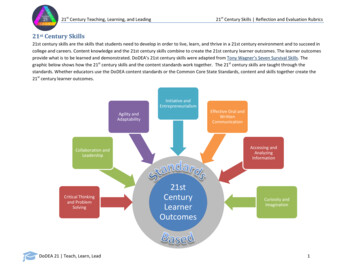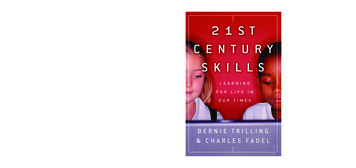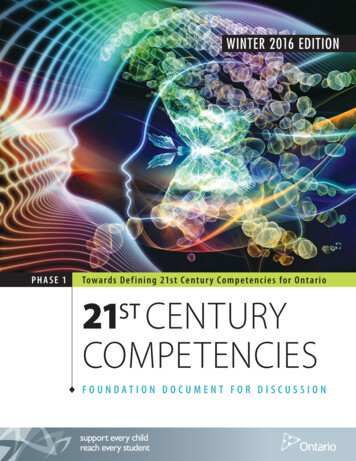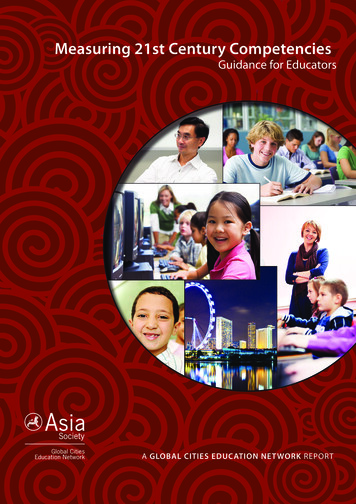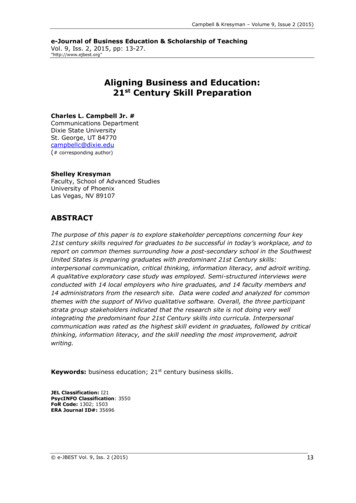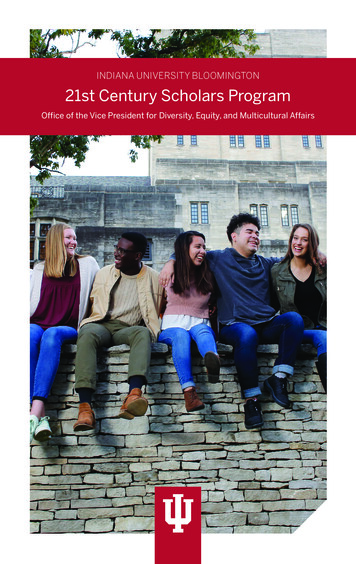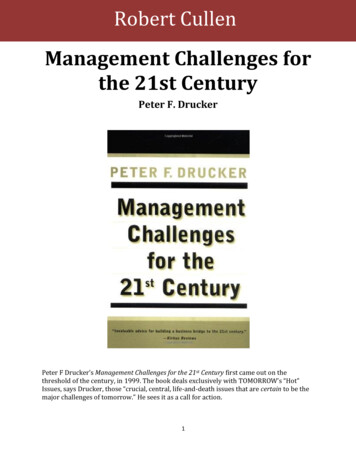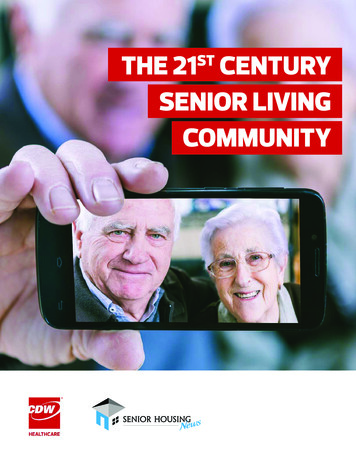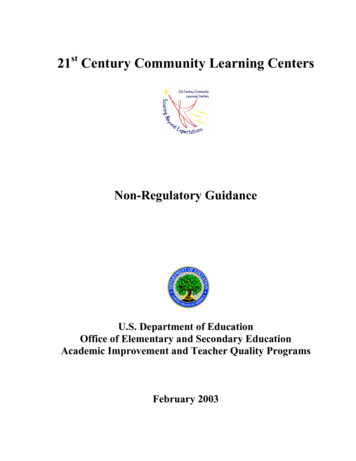
Transcription
21st Century Community Learning CentersNon-Regulatory GuidanceU.S. Department of EducationOffice of Elementary and Secondary EducationAcademic Improvement and Teacher Quality ProgramsFebruary 2003
United States Department of EducationDear Colleague:I am pleased to share with you this updated Non-Regulatory Guidance for the 21st CenturyCommunity Learning Centers program. This document is designed to help State educationalagencies (SEAs) and eligible public and private schools and organizations throughout thecountry understand how they can successfully participate in this important initiative. Since thetime that the previous draft version was released in May 2002, the Department has clarifiedand expanded the Guidance in response to inquiries received from the field.The 21st Century Community Learning Centers program is authorized under Title IV, Part B,of the Elementary and Secondary Education Act, as amended by the No Child Left Behind Actof 2001. The purpose of this important program is to create community learning centers thatprovide academic enrichment opportunities for children, particularly students who attend highpoverty and low-performing schools, to meet State and local student standards in coreacademic subjects, to offer students a broad array of enrichment activities that can complementtheir regular academic programs, and to offer literacy and other educational services to thefamilies of participating children.The Non-Regulatory Guidance can help the State Educational Agencies to develop selectioncriteria to ensure that local programs are of the highest possible quality and are appropriatelytailored to address the needs of students and their families. In particular, States and localcommunities must identify and implement programs for which there is evidence, based onrigorous research and evaluation, that they can effectively help children to succeed in school.The No Child Left Behind Act of 2001 recognizes that improved student achievement occurswhen communities implement programs and strategies scientifically proven to be effective.The 21st Century Community Learning Centers program is committed to ensuring that ourstudents have access to high-quality and engaging enrichment activities that can truly supporttheir learning and development. I look forward to working with you on this exciting program.If you have questions or need further information regarding the 21st Century CommunityLearning Centers program, please contact Carol J. Mitchell, the 21st Century CommunityLearning Centers Program Manager, at (202) 260-0982 or via e-mail tocarol.j.mitchell@ed.gov. Eugene W. HickockUnder Secretary400 MARYLAND AVE, SW, WASHINGTON, DC 20202-6200Our mission is to ensure equal access to education and to promote educationalexcellence throughout the nation.
Page 1 — 21st Century Community Learning CentersNon-Regulatory GuidanceTABLE OF CONTENTSSECTION A. INTRODUCTIONSECTION B. OVERVIEW OF THE 21ST CENTURY COMMUNITY LEARNINGCENTERS (21ST CCLC) PROGRAMB-1. What is the purpose of the 21st CCLC Program?B-2. How has the program changed?B-3. Which requirements apply to State educational agencies and which apply to localapplicants?B-4. What is a community learning center?B-5. What is the relationship between the 21st CCLC and other Federal programs?SECTION C. FEDERAL AWARDS TO STATESC-1. How are 21st CCLC funds allocated to the States?C-2. What is the definition of State under the 21 st CCLC program?C-3. Must the outlying areas run competitions for local communities?C-4. Are unitary districts required to hold a competition within the district to distributefunds?C-5. How and when does a State educational agency submit its application for 21stCCLC funds?C-6. What happens to a State s allocation if it does not apply for, or is not approvedfor, 21st CCLC funds?C-7. When will 21st CCLC funds become available to State?C-8. How long will a State application be in effect, and what is the duration of a Stateaward?C-9. How long are 21st CCLC funds available for obligation?SECTION D. STATE APPLICATION REQUIREMENTSD-1. What are the key issues that must be addressed in a State educational agency sapplication for 21st CCLC funds?D-2. Under what condition would the Secretary disapprove a State application, andwhat happens if a State s application is not approved?D-3. How must States develop their applications?SECTION E. FUNDS RESERVED FOR STATE USEE-1. May a State educational agency reserve a portion of its allocation for State use?E-2. What flexibility does the State have in using the funds reserved for Stateadministration and activities?E-3. Can SEA s conduct applicant workshops?SECTION F. STATE COMPETITIVE GRANTS TO LOCAL ENTITIESF-1. What organizations are eligible to apply for 21t CCLC funds?F-2. Is a local application eligible to apply for a grant if it has no prior after-schoolexperience?F-3. What must a local organization include in its application to an SEA?F-4. Are there any required priorities for awarding local grants?
Page 2 — 21st Century Community Learning CentersNon-Regulatory GuidanceF-5. Can a State include other priorities in the local grant competition?F-6. What is the minimum amount of 21st CCLC funds that an SEA may provide to agrants?F-7. What is the period of a local 21st CCLC award?F-8. Does the 21st CCLC program have a local matching requirement? If so, what is itand what organizations can provide the match?F-9. Is collaboration a requirement for LEAs and other public or private organizationseligible to apply?F-10. May a community learning center be located or take place outside of a school?F-11. Are there any requirements for the hours of operation of a center or the number ofstudents a location program must serve?F-12. Can SEAs award local grants to schools that already receive Federal 21st CCLCprogram funds?F-13. May 21st CCLC program funds support communities that are alreadyimplementing before- and after-school activities.F-14. May an SEA use 21st CCLC funds to award a planning grant to an organizationthat currently does not provide any out-of-school time activities?F-15. Are religious organizations, including entities such as religious private schools,eligible to receive 21st CCLC grants from the SEA?F-16. Are private school students eligible to participate in 21st CCLC activities carriedout in public schools?F-17. May several organizations form a consortium to apply for 21st CCLC funds?F-18. May States reserve their first-year funding, or a portion of their funding, tosupport current Federal 21st CCLC grantees whose program are ending?F-19. How does the legislative requirement for a minimum award of 50,000 per grantapply to a consortium of organizations?F-20. Are public charter schools eligible to participate in the 21st CCLC program?F-21. May an intermediate unit within a State apply for 21st CCLC program funds onbehalf of eligible schools for which it provides services?F-22. Can BIA schools apply to the State and the BIA?F-23. How flexible is the timing of the local grant competition?F-24. Can a State begin a competition for local grants before the Department approvesits application?F-25. Does an SEA have discretion in selecting criteria for its local competition?F-26. Who may serve as peer reviewers for local competitions?F-27. Can a State opt to have the Department continue to administer its allocation ofthe funds?F-28. Can two or more States combine their grant review process?F-29. One what basis does an SEA make continuation awards?SECTION G. LOCAL USE OF FUNDSG-1. For what activities may a grantee use 21st CCLC program funds?G-2. Can 21st CCLC program funds support services to adults?G-3. Can 21st CCLC program funds support services for pre-kindergarten children?G-4. Several civil rights laws apply to recipients of Federal grants. Do these lawsapply to private organizations that receive a grant under this program?
Page 3 — 21st Century Community Learning CentersNon-Regulatory GuidanceG-5. What flexibility does a local educational agency have in its uses of 21st CCLCprogram funds?G-6. Can 21st CCLC activities take place during the regular school day?G-7. Can 21st CCLC local grantees use funds other Federal, State and local programsthat have related purposes?G-8. How does 21st CCLC fit within the broader context of a school s improvementplan?G-9. May LEAs or other organizations charge indirect costs to their 21st CCLC grant?G-10. May a grantee charge pre-award costs to the 21st CCLC grant?G-11. Can a local grantee charge the 21st CCLC grant for costs incurred after the grantperiod?G-12. How does the carryover provision apply to 21st CCLC funds at the local level?G-13. May a local grantee use 21st CCLC program funds to pay or reimburse aproposal-writing firm for developing its grant application?G-14. Must community learning centers provide services free of charge?SECTION H. EVALUATION AND ACCOUNTABILITYH-1. What information will the Department collect from SEA?H-2. What evidence is required from the States and local programs to determinewhether 21st CCLC programs are research-based and effective?H-3. What is scientifically based research?H-4. When is scientifically based research appropriate for the 21st CCLC programs?H-5. What are the State evaluation requirements?H-6. What are the evaluation requirements for local grantees?H-7. What are the Department s plans for the national evaluation of the 21st CCLCprogram?H-8. How does a State ensure that organizations other than LEA will be able toprovide academic enrichment and have access to student achievement data?SECTION I. MISCELLANEOUSI-1. What portions of the Education Department s General Administrative Regulations(EDGAR) apply to the 21st CCLC program?APPENDIX ARESOURCES ON AFTER-SCHOOLAPPENDIX B — 21ST CENTURY COMMUNITY LEARNING CENTERS STATEALLOCATIONS FOR FY 2002APPENDIX C —21ST CENTURY COMMUNITY LEARNING CENTERS STATUTE
Page 4 — 21st Century Community Learning CentersNon-Regulatory GuidanceSECTION A. INTRODUCTIONOver the last ten years, a growing body of research studies and evaluations has assessed thecharacteristics and the benefits of after-school programs. Initially, evaluations of after-schoolprograms focused not on academic outcomes, but on the quality of program implementation,and most of those studies did not employ scientifically rigorous evaluation designs. This hasbegun to change as the U.S. Department of Education (ED), foundations, after-school programdevelopers and sponsors, and State and local agencies have invested considerable resourcesinto assessing whether well-designed and well-implemented after-school programs can havemeasurable effects on student academic performance and behavior.In February 2003, early findings from an ED-funded study of the 21st Century CommunityLearning Centers (21st CCLC) program, conducted by Mathematica Policy Research, Inc.,were released in a report titled When Schools Stay Open Late. In general, the first-yearfindings showed that typical 21st CCLC programs had a negligible impact on academic andbehavioral outcomes for students. The study design was the most rigorous ever used to assessthe benefits of after-school programs. It included a representative national sample of middleschools, examining data from matched comparison groups of 4,400 middle-school students in34 schools districts with 62 Community Learning Centers. The study also examined afterschool programs in 7 elementary school districts in which approximately 1,000 students wererandomly assigned to participate or not.The first-year findings revealed that participating in these programs had little influence onacademic performance and no influence on feelings of safety or on the number of "latchkey"kids, although the proportion of students being cared for by an older sibling was reduced andCenters did show increased parental involvement. The study also showed that 21st CCLCprograms — particularly at the middle-school level — had low levels of student participation andoverall did not offer high-quality academic enrichment experiences.Clearly, these findings suggest that 21st CCLC program managers and service providers mustdo a better job of delivering exciting, engaging and purposeful enrichment activities, validatedby research, that can increase student participation and contribute more directly to supportingacademic growth and positive youth development. Since the Mathematica study began, therehave been significant changes to the 21st CCLC program. The No Child Left Behindlegislation gave the States the responsibility to focus 21st CCLC programs on providingacademic and other enrichment opportunities to children in high-poverty, low-performingschools, and to help these children succeed in meeting State and local academic standards.Continued research and rigorous evaluations, coupled with carefully designed technicalassistance to help after-school programs put in place exciting and engaging learning activitiesbased on sound research on teaching and learning, will be critical to ensure that no child is leftbehind. The U.S. Department of Education is looking forward to its continuing work with theStates and local communities across the country to address these challenges.
Page 5 — 21st Century Community Learning CentersNon-Regulatory GuidanceThe 21st Century Community Learning Centers ProgramThe passage of the No Child Left Behind Act of 2001, which significantly amended theElementary and Secondary Education Act to expand State and local accountability andflexibility and to stress the adoption of research-based practice, contained a number of newprovisions that specifically affected the 21st Century Communities Learning Centers (21stCCLC) program.The remainder of this document focuses on the requirements of the statute and theDepartment s interpretation of these provisions. Throughout this document, we have tried toprovide guidance that clearly interprets the requirements of the statute, represents the findingsof research and experience, promotes high-quality programs that directly assist student learningand achievement, and ensures that diverse stakeholders within each community are involved inplanning and delivering program services.SECTION B. OVERVIEW OF THE 21st CENTURY COMMUNITY LEARNINGCENTERS (21st CCLC) PROGRAMB-1: What is the purpose of the 21st CCLC program?The purpose of the program is to establish or expand community learning centers that providestudents with academic enrichment opportunities along with activities designed to complementthe students regular academic program. Community learning centers must also offer familiesof these students literacy and related educational development. Centers — which can be locatedin elementary or secondary schools or other similarly accessible facilities — provide a range ofhigh-quality services to support student learning and development, including tutoring andmentoring, homework help, academic enrichment (such as hands-on science or technologyprograms), and community service opportunities, as well as music, arts, sports and culturalactivities. At the same time, centers help working parents by providing a safe environment forstudents during non-school hours or periods when school is not in session.Authorized under Title IV, Part B, of the Elementary and Secondary Education Act (ESEA), asamended by the No Child Left Behind Act of 2001, the law s specific purposes are to: (1)provide opportunities for academic enrichment, including providing tutorial services to helpstudents (particularly students in high-poverty areas and those who attend low-performingschools) meet State and local student performance standards in core academic subjects such asreading and mathematics; (2) offer students a broad array of additional services, programs, andactivities, such as youth development activities, drug and violence prevention programs,counseling programs, art, music, and recreation programs, technology education programs, andcharacter education programs, that are designed to reinforce and complement the regularacademic program of participating students; and (3) offer families of students served bycommunity learning centers opportunities for literacy and related educational development.B-2: How has the program changed?The No Child Left Behind Act of 2001 made several significant changes to the 21st CCLCprogram. These changes ensure that the program focuses on helping children in high-need
Page 6 — 21st Century Community Learning CentersNon-Regulatory Guidanceschools succeed academically through the use of scientifically based practice and extendedlearning time. The new statute provides additional State and local flexibility in how funds canbe used to support higher academic achievement, and dramatically expands eligibility for 21stCCLC funding to public and private educational and youth-serving organizations.Changes to the program s authorizing statute include: Implementing activities based on rigorous scientific research. For the first time, thenew authorizing statute provides principles of effectiveness to guide local grantees inidentifying and implementing programs and activities that can directly enhance studentlearning. These activities must address the needs of the schools and communities, becontinuously evaluated using performance measures, and — if appropriate — be based onscientific research. Focusing services on academic enrichment opportunities. Under the newlegislation, grantees must provide academic enrichment activities to students in highpoverty schools to help them meet State and local standards in the core content areas,such as reading, math, and science. In addition, applicants must also provide servicesto the families of children who are served in the program. Under the previous statute,grantees provided a broad array of services to children and community members. Thenew legislation allows community learning centers to serve adult family members ofstudents, but not community members at large. Transferring program administration from the Federal to the State level. The newlegislation turns over responsibility for administering the 21st CCLC program to theState educational agency (SEA) in each State. The U.S. Department of Education (theDepartment) will allocate funds to the SEAs by formula. The SEA will manage grantcompetitions and award grants to eligible organizations for local programs. States nowwill be accountable to the Department for ensuring that all statutory requirements aremet. Under the previous legislation, the Department managed a nationwidecompetition and directly awarded over 1,600 grants to public schools and schooldistricts that worked in collaboration with other public and nonprofit organizations,agencies, and educational entities. Expanding eligibility to additional entities. The new legislation allows public andprivate organizations to receive funds directly from the State under this program.Under the previous authority, only public schools or local educational agencies coulddirectly receive grants. The Department continues to strongly encourage all applicantsto collaborate with other public and private agencies, including the local schooldistricts, to create programs as comprehensive and high-quality as possible. Targeting services to poor and low-performing schools. The new legislationrequires States to award grants only to applicants that will primarily serve students whoattend schools with a high concentration of poor students. In addition, States must givepriority to applications for projects that will serve children in schools designated as inneed of improvement under Title I and that are submitted jointly by school districtsreceiving Title I funds and community-based organizations or public or private
Page 7 — 21st Century Community Learning CentersNon-Regulatory Guidanceorganizations. These priorities are new. The previous legislation restricted eligibilityto inner-city or rural schools and strongly encouraged schools to collaborate withcommunity-based organizations. Extending the duration of grant awards. States now have the discretion to awardgrants to local organizations for a period of three to five years. The previous lawlimited the duration of the grants to three years. Increasing accountability at the State and local levels. The new legislation requiresStates to develop performance indicators and performance measures that they can useto evaluate programs and activities. States must require local grantees to implementprograms that meet the principles of effectiveness. In addition, grantees mustperiodically evaluate their programs to assess progress toward achieving the goal ofproviding high-quality opportunities for academic enrichment. Expanding the range of locations in which local programs may take place. Thenew legislation provides support for services for children and their families inelementary or secondary schools or in any other location that it is at least as availableand accessible as the school. The previous legislation allowed for community learningcenters to be located only in public elementary or secondary schools. Requiring funds to supplement and not supplant. Grantees must use program fundsto supplement and not supplant other Federal, State, and local funds. This supplementnot supplant provision was not included in the previous statute. Allowing States to require a local match. States may now require local grantees tomatch funds. Under the previous law no match was required. Requiring consultation and coordination. States must, in their State application,provide an assurance that the State application was developed in consultation andcoordination with appropriate State officials, including the chief State school officer,other State agencies administering before- and after-school (or summer school)programs, the heads of the State health and mental health agencies or their designees,and representatives of teachers, parents, students, the business community, andcommunity-based organizations, including faith-based organizations. Providing States with funds to carry out administrative responsibilities. Up to fivepercent of a State s 21st CCLC allocation may be reserved by the State for theadministrative and support responsibilities associated with implementing a qualityprogram. These funds may be used to plan the competition, manage a peer-reviewprocess, award the grants, and monitor progress. State-level funds also may be used tostrengthen the programs to provide training and technical assistance to the localgrantees and to conduct evaluations.
Page 8 — 21st Century Community Learning CentersNon-Regulatory GuidanceB-3: Which requirements apply to State educational agencies and which apply to localapplicants?There are two levels of program requirements under the new statute. First, section 4203(a)describes requirements that the SEA must address in its application to the Department (seequestion D-1). Second, section 4204(b)(2) describes requirements that an eligible entity at thelocal level must address in its application to the State (see question F-3). Both levels ofrequirements are mandated by statute and must be addressed and implemented.B-4: What is a community learning center?A community learning center offers academic, artistic, and cultural enrichment opportunities tostudents and their families during non-school hours (before or after school) or periods whenschool is not in session (including holidays, weekends or summer recess). According tosection 4201(b)(1) of the program statute, a community learning center assists students inmeeting State and local academic achievement standards in core academic subjects, such asreading and mathematics, by providing the students with opportunities for academicenrichment. Centers also provide students with a broad array of other activities — such as drugand violence prevention, counseling, art, music, recreation, technology, and charactereducation programs — during periods when school is not in session. Community learningcenters must also serve the families of participating students, e.g., through family literacyprograms.B-5: What is the relationship between the 21st CCLC and other Federal programs?The 21st CCLC serves as a supplementary program that can enhance State or local reformefforts to improve student academic achievement and to support their overall development. Inparticular, 21st CCLC funds will create and expand after-school programs that offer extendedlearning opportunities for children and their families. Once these programs have beenestablished with 21st CCLC funds, other Federal, State, or local funds can also be used toprovide activities and services in these centers. Some illustrative examples of how 21st CCLCprograms can operate in conjunction with other Federal programs to meet mutual goals andprovide additional resources to target populations are provided below.
Page 9 — 21st Century Community Learning CentersNon-Regulatory GuidanceExperience & PracticeTitle I funds, in concert with the 21st CCLC program funds, can provide extended learningprograms in schools that integrate enrichment and recreation opportunities with academicservices. 21st CCLC program funds can also meet the needs of parents seeking supplementaleducational services (such as tutoring and academic enrichment) for their children. Local 21stCCLC programs may also work in collaboration with programs to supplement services totarget populations such as migrant students.Other Federal programs can also complement local 21st CCLC programs. Many current 21stCCLC programs are eligible to receive funds through the U.S. Department of Agriculture(USDA) Food and Nutrition Service for After-school Snacks, and in some cases to providesupper to young children. Local communities can also participate in USDA s Summer FoodService program. These snacks and meals can contribute to the nutritional services provided inlocal programs. Services made available through funds from Temporary Assistance to NeedyFamilies (administered by the U.S. Department of Health and Human Services) can becombined with 21st CCLC programs to serve children outside of the regular school day. 21stCCLC programs can also utilize Federal funding available through local prevention grantsunder Title V of the Juvenile Justice and Delinquency Prevention Act (administered by theOffice of Juvenile Justice and Delinquency Prevention in the U.S. Department of Justice).Further information on local prevention grants can be found on the OJJDP n no case, however, may 21st CCLC funds supplant other Federal, State or local funds (seequestion G-7 for more information).SECTION C. FEDERAL AWARDS TO STATESC-1: How are 21st CCLC funds allocated to the States?In fiscal year (FY) 2002, Congress appropriated 1 billion for the 21st CCLC program. Fromthat total appropriation, the Department will reserve: (1) the amount needed to support thecontinuation costs of awards made by the Department through the earlier competitive grantprogram; (2) up to 1 percent to carry out national activities; and (3) up to 1 percent for grantsto the Bureau of Indian Affairs and Outlying Areas (Guam, American Samoa, the VirginIslands, and the Commonwealth of the Northern Mariana Islands). The Department willallocate the remaining funds to States in proportion to each State s share of funds in theprevious fiscal year under Part A of Title I of the Elementary and Secondary Education Act(ESEA). However, no State will receive less than one-half of 1 percent of the total amountavailable for States. In FY 2002, the Department will allocate approximately 305 million tothe States and 10 million to the BIA and Outlying Areas, and will reserve 675 million forcontinuations of current grants and 10 million for national leadership activities (includingevaluation). See Appendix C for the estimated FY 2002 State allocations.
Page 10 — 21st Century Community Learning CentersNon-Regulatory GuidanceNote: The Freely Associated States (the Republic of the Marshall Islands, the Federated Statesof Micronesia, and the Republic of Palau) are no longer eligible to receive funding under thisprogram.C-2: What is the definition of State under the 21st CCLC program?For the purposes of this program, the definition of State (Section 4201(b)(4)) includes the 50States, the Commonwealth of Puerto Rico, and the District of Columbia.C-3: Must the outlying areas run competitions for local communities?Guam, American Samoa, the Virgin Islands, and the Commonwealth of the Northern MarianaIslands must hold a competition to distribute funds to local communities if they are going touse 21st CCLC funds for its statutory purposes. However, if these island entities choose to usetheir authority to consolidate their 21st CCLC funds under another applicable ESEA program -and not spend their funding on after-school programs -- a local 21st CCLC competition is notnecessary.C-4: Are unitary districts required to hold a competition within the district to distributefunds?Yes. Hawaii, the District of Columbia, and Puerto Rico must conduct a grant competition toensure that all eligible organizations — including all public or private entities and not just publicschools and districts — can have a chance to compete for 21st CCLC grants.C-5: How and when does a State educational agency submit its application for 21stCCLC funds?A State educational agency may submit its application for 21st CCLC funds in either of twoways. The State may request 21st CCLC funds as part of a consolidated ESEA application(under Section 9302), or it may submit a separate 21st CCLC program application. TheOutlying Areas have their own consolidated application to which different guidelines apply.The consolidated application allows the State to submit one application for up to 12 formulagrant programs under ESEA. The Department has 120 days to approve the State application orrequest additiona
Page 3 — 21st Century Community Learning Centers Non-Regulatory Guidance G-5. What flexibility does a local educational agency have in its uses of 21st CCLC program funds? G-6. Can 21st CCLC activities take place during the regular school day? G-7. Can 21st CCLC local grantees use funds other Federal, State and local programs that have related purposes?
